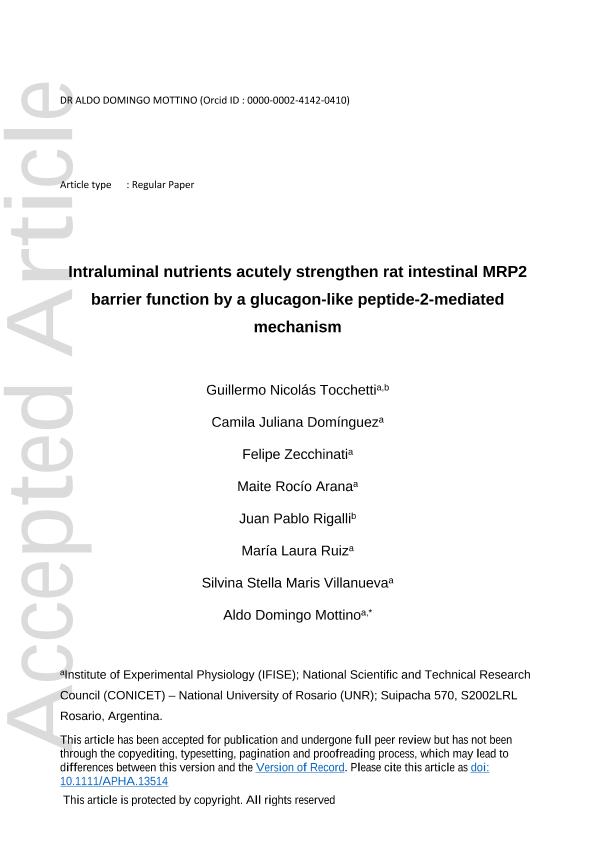Artículo
Intraluminal nutrients acutely strengthen rat intestinal MRP2 barrier function by a glucagon-like peptide-2-mediated mechanism
Tocchetti, Guillermo Nicolás ; Dominguez, Camila Juliana
; Dominguez, Camila Juliana ; Zecchinati, Felipe
; Zecchinati, Felipe ; Arana, Maite Rocío
; Arana, Maite Rocío ; Rigalli, Juan P.; Ruiz, Maria Laura
; Rigalli, Juan P.; Ruiz, Maria Laura ; Villanueva, Silvina Stella Maris
; Villanueva, Silvina Stella Maris ; Mottino, Aldo Domingo
; Mottino, Aldo Domingo
 ; Dominguez, Camila Juliana
; Dominguez, Camila Juliana ; Zecchinati, Felipe
; Zecchinati, Felipe ; Arana, Maite Rocío
; Arana, Maite Rocío ; Rigalli, Juan P.; Ruiz, Maria Laura
; Rigalli, Juan P.; Ruiz, Maria Laura ; Villanueva, Silvina Stella Maris
; Villanueva, Silvina Stella Maris ; Mottino, Aldo Domingo
; Mottino, Aldo Domingo
Fecha de publicación:
06/2020
Editorial:
Wiley Blackwell Publishing, Inc
Revista:
Acta Physiologica
ISSN:
1748-1708
Idioma:
Inglés
Tipo de recurso:
Artículo publicado
Clasificación temática:
Resumen
Aim: MRP2 is an intestinal ABC transporter that prevents the absorption of dietary xenobiotics. The aims of this work were: (1) to evaluate whether a short-term regulation of intestinal MRP2 barrier function takes place in vivo after luminal incorporation of nutrients and (2) to explore the underlying mechanism. Methods: MRP2 activity and localization were assessed in an in vivo rat model with preserved irrigation and innervation. Nutrients were administered into distal jejunum. After 30-minutes treatments, MRP2 activity was assessed in proximal jejunum by quantifying the transport of the model substrate 2,4-dinitrophenyl-S-glutathione. MRP2 localization was determined by quantitative confocal microscopy. Participation of extracellular mediators was evaluated using selective inhibitors and by immunoneutralization. Intracellular pathways were explored in differentiated Caco-2 cells. Results: Oleic acid, administered intraluminally at dietary levels, acutely stimulated MRP2 insertion into brush border membrane. This was associated with increased efflux activity and, consequently, enhanced barrier function. Immunoneutralization of the gut hormone glucagon-like peptide-2 (GLP-2) prevented oleic acid effect on MRP2, demonstrating the participation of this trophic factor as a main mediator. Further experiments using selective inhibitors demonstrated that extracellular adenosine synthesis and its subsequent binding to enterocytic A2B adenosine receptor (A2BAR) take place downstream GLP-2. Finally, studies in intestinal Caco-2 cells revealed the participation of A2BAR/cAMP/PKA intracellular pathway, ultimately leading to increased MRP2 localization in apical domains. Conclusion: These findings reveal an on-demand, acute regulation of MRP2-associated barrier function, constituting a novel physiological mechanism of protection against the absorption of dietary xenobiotics in response to food intake.
Palabras clave:
ADENOSINE
,
GLP-2
,
INTESTINAL BARRIER
,
INTESTINE
,
MRP2
,
OLEIC ACID
Archivos asociados
Licencia
Identificadores
Colecciones
Articulos(IFISE)
Articulos de INST.DE FISIOLOGIA EXPERIMENTAL (I)
Articulos de INST.DE FISIOLOGIA EXPERIMENTAL (I)
Citación
Tocchetti, Guillermo Nicolás; Dominguez, Camila Juliana; Zecchinati, Felipe; Arana, Maite Rocío; Rigalli, Juan P.; et al.; Intraluminal nutrients acutely strengthen rat intestinal MRP2 barrier function by a glucagon-like peptide-2-mediated mechanism; Wiley Blackwell Publishing, Inc; Acta Physiologica; 230; 4; 6-2020; 1-43
Compartir
Altmétricas



